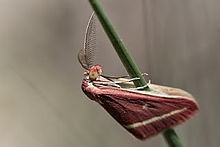Casilda Consecraria
| Casilda Consecraria | ||||||||||||
|---|---|---|---|---|---|---|---|---|---|---|---|---|

Casilda Consecraria |
||||||||||||
| Systematics | ||||||||||||
|
||||||||||||
| Scientific name | ||||||||||||
| Casilda Consecraria | ||||||||||||
| ( Staudinger , 1871) |
Casilda consecraria is a butterfly fromthe Spanner family (Geometridae).
features
butterfly
The moths reach a wingspan of 16 to 24 millimeters. The color of the upper side of the forewing is usually rust-red to beige-red. The wide and very straight outer transverse line stands out whitish. A small discal spot is also colored whitish. There are regional specimens that are cream-colored and show a red-brown outer transverse line. In all forms, the upper side of the hind wing is almost indistinctly whitish in color, sometimes with an indistinct gray transverse line. The antennae of the males are combed, those of the females have short teeth.
Caterpillar
Fully grown caterpillars are light brown or gray-brown with little drawing, sometimes dark brown on the back. In the resting position they take a stretched posture, imitating a withered, broken branch.
Similar species
- The moths of Casilda antophilaria are distinguished by the gray upper side of the hind wings.
- In the moths of Rhodometra sacraria the discal spot on the upper side of the forewing is blackish, which distinguishes them from the brightly colored specimens of Casilda consecraria , whose discal spot is whitish.
distribution and habitat
The distribution area of Casilda consecraria extends through Spain and southern France to the Levant . The species is also found in Sicily , Sardinia and Cyprus . In the southeast, the occurrence extends to the Arabian Peninsula , Iran and Kazakhstan . Casilda consecraria is also found in North Africa. The main habitat are hot, dry regions near the coast as well as salt steppes and salt marshes. In the mountains of Morocco , the species rises to heights of 1500 meters.
Way of life
The moths are diurnal and nocturnal and are very faithful to their location. They fly in three generations between February and October. At night they appear on artificial light sources . The caterpillars feed on sea lavender species ( Limonium ), in Spain exclusively on the flowers of Limonium dichotomum . In other regions they were also found on the flowers and leaves of winged sea lavender ( Limonium sinuatum ) and steppe veil sea lavender ( Limonium gmelinii ).
Individual evidence
- ↑ a b c Victor M. Redondo, Javier Gastón, Ramón Gimeno: Geometridae Ibericae , Apollo Books, Stenstrup, 2009, ISBN 978-87-88757-81-1 , p. 172
- ↑ a b c Axel Hausmann: The Geometrid Moths of Europe, 2. Sterrhinae. Apollo Books, Stenstrup 2004, ISBN 87-88757-37-4 , pp. 435/436
literature
- Axel Hausmann: The Geometrid moths of Europe, 2nd Sterrhinae. Apollo Books, Stenstrup 2004, ISBN 87-88757-37-4
- Victor M. Redondo, Javier Gastón, Ramón Gimeno: Geometridae Ibericae , Apollo Books, Stenstrup, 2009, ISBN 978-87-88757-81-1
- Gareth Edward King & José Luis Viejo: A contribution to an understanding of the biology and early stage morphology of Casilda consecraria (Staudinger, 1871) (Insecta: Lepidoptera: Geometridae) , Zoosystema 39 (4), 2017, pp. 463–472, ( doi : 10.5252 / z2017n4a2 )
Web links
- Lepiforum e. V. - Taxonomy and photos
- Casilda consecraria at Fauna Europaea. Retrieved May 26, 2020
- pyrgus.de - Butterflies and their ecology
- leps.it - Moths and Butterflies of Europe and North Africa

